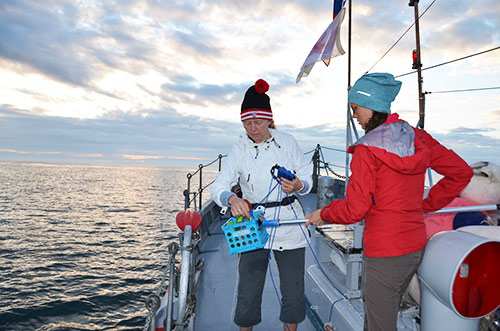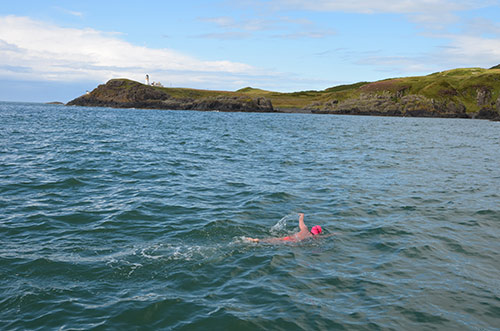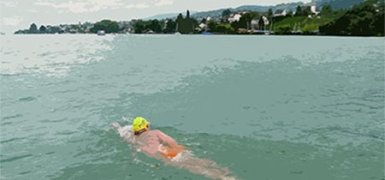
Abhejali Bernardova became the first person from the Czech Republic to swim the North Channel on August 15th 2017 in 10 hours, 23min, 48 seconds. Crew member Dhavala Stott was kind enough to write a few words telling us what it was like to be on the boat...
It's 5am and I'm on a converted lifeboat leaving Donaghadee harbour on the eastern Northern Irish coast. There's a little wind, and a faint red glow of sunrise peeps between the clouds as we look across the twenty-one mile stretch of water towards Scotland. This is the day that my good friend from the Sri Chinmoy Marathon Team, Abhejali Bernardova, will attempt to be the first swimmer from her native Czech Republic to successfully swim the North Channel.
It's a body of water that is particularly challenging to swim for several reasons. There are swarms of lion's mane jellyfish, sometimes such that swimmers have been stung over 100 times on a North Channel attempt. Abhejali had been badly stung by box jellyfish on her Molokai strait crossing in April this year - for several months she carried a faint scarring from these stings. Because of this, she was initially quite wary about the threat the jellyfish might pose here. There's also the cold water which averages between 11-14 degrees and poses a serious threat of hypothermia. And there is the variable and unpredictable weather in these parts - think of all the cliches you've ever heard about typical Scottish/Irish summer weather and that's what we were looking to avoid. The ideal day would have very little wind and a good amount of sunshine so the swimmer doesn't get too cold. We were also looking for favourable tides. Many channel swimmers have found themselves at the mercy of the strong unpredictable currents which pull them off course as they approach Scotland.
As Abhejali took her first determined strokes, leaving Ireland at 5.29am, it seemed like a small victory that she had the opportunity to make the crossing at all that day. Abhejali had a six day swim window but the forecast throughout the whole week wasn't promising. Tuesday looked like the only day with potentially swimmable conditions. When the boat pilot for the swim, Quinton Nelson had called us at 6.30 the previous evening he said there was only a 50-50 chance the swim could go ahead the next day. He said the latest forecast had worsened, showing high winds (force 6-7) towards Scotland later in the day which would make it almost impossible to reach the Scottish coast. He asked Abhejali if she was happy to meet at 5am at the boat for a final decision, and made it clear that if the forecast didn't improve we wouldn't be going anywhere the next morning. Abhejali said she definitely wanted to be ready if there was any chance to go. She was completely surrendered to the situation and trusted Quinton that he would make the right call to give her the best possible chance of a successful swim and to keep her safe. It wasn't until the day after the swim that Quinton told us how very close he was to phoning back and cancelling on Monday night. Given how things turned out we were all grateful that he had the patience and experience to wait and see what the morning brought.
We were a support crew of 3 - myself, Jana (Abhejali's younger sister) and Jayalata, also from the Czech Republic who has herself been part of a successful English Channel relay team and been crew on many of Abhejali's previous swims. We had all been part of Abhejali's crew for her English Channel swim in 2011 and were happy to be reunited, a little further north, for this one.

Coming from Edinburgh, I was especially excited about this swim as it felt like Abhejali was swimming 'home'! On Monday evening Abhejali had sent out a message to many friends around the world asking them to pray for the weather forecast to improve. When the morning came we were expecting a discussion about conditions and I think Abhejali was even ready to be faced with a decision whether to go ahead in less than favourable conditions, or take a chance and wait to see if she would get a better opportunity. When we arrived at the marina Quinton looked at Abhejali and asked "Are you good?" She said yes and he turned and walked towards his boat. It was only when the boat started moving that Abhejali realised that brief exchange of words was the agreement for the swim to go ahead!

Abhejali arrived in Donaghadee very well prepared. Knowing that staying in the cold water long enough could be the greatest obstacle of this swim, she came to Scotland twice to train and take advantage of our beautifully cool summer temperatures compared to the heatwave in her native Czech Republic! She first visited Edinburgh in early June and swam in the beaches along the East Lothian coast. At this time the water was around 11-12 degrees and she initially struggled to stay in longer than an hour and a half. I then spent a week with her in Ullapool in July where we were hosted by longtime members of the Sri Chinmoy Marathon team Suruchi and Tirthika Gero. Over the course of 6 days she put in a total of 21 hours in the water, including a 6 hour swim in temperatures below 13 degrees. Some days it was probably closer to 11. Through those swims I could see how cold she was, with her hands visibly shaking at times when she came in to feed. Still, she kept returning to the water, knowing that each hour of training would be valuable for her body's ability to handle the hours she would face in the North Channel. Another bonus, if you could see it that way, of these training swims was that Abhejali encountered Lion's mane jellyfish (they love the cold Scottish water!). She was stung a few times by them, and found the stings not as painful as those she got in Hawaii. This meant that even though she was stung about a dozen times on the actual swim (we could see the jellyfish from the boat) it was something she had trained with and knew she could swim through.

Abhejali made a strong confident start and covered 6.5 miles in the first 2.5 hours and was halfway in just over 4 hours. Both the pilot and the official observer said that although the weather wasn't ideal and there would be some wind it was better than we could have hoped for from the forecast and that she had been given a real opportunity for a successful swim. Within the first few hours we saw dolphins, a seal and a rainbow from the boat, all of which we took as good omens. Quinton asked that Abhejali swim the first hour without stopping in order to avoid strong currents close to the Irish coast. She then stopped every half hour to feed. We had a routine of waving a red towel five minutes before feeding. She drank mainly fresh ginger tea with maltrodextrin and 'ate' mainly liquidised porridge. Later in the day she started agreeing to the soup we had been offering her for several hours and she also munched on bananas and pieces of crystallised ginger. Jayalata added a variety of 'extras' to these drinks - magnesium, warming pills, anti-histamine for the jellyfish stings. We fed her these concoctions in bottles attached to a rope which we put in a basket with a long handle. To avoid getting too cold or being carried off course by the currents we tried to keep feeds as short as possible, ideally within 30 seconds and certainly no more than a minute.
All the preparation seemed to be paying off as Abhejali told us after about five hours that she wasn't feeling cold. She was also avoiding sea-sickness, which had plagued her on several of her other swims. We were also happily avoiding sea-sickness on the boat. As recommended by Jayalata I stuck to eating white bread jam sandwiches and the odd piece of chocolate (the chocolate wasn't particularly recommended but I seemed to get away with it!) Somewhere near the middle part of the swim the wind picked up and the sea was noticeably more choppy than at the start. Abhejali commented on one feed that is was like a battlefield to swim through the waves. We counted stroke rate every half hour and Abhejali noted afterwards that it was higher than her usual stroke rate of 48-52 and that she was basically swimming as hard as possible to stay warm. Starting at 57, she dropped to 52-53 between hours 5 and 8, then increased to 55 for the last few hours.

We were sending messages about Abhejali's progress to many friends around the world who were then sending back messages of support. We would write some of the messages on a whiteboard for her to read and she would often smile when she read them. These messages and prayers of encouragement and camaraderie, received both during and after her swims are something Abhejali really treasures. When there was around 5 miles still to go the pilot said she could be on course for a finish of under eleven hours. Jayalata conveyed the message at the next feed stop that if she kept going at the same pace she would finish 'in ten hours'. Abhejali looked extremely confused by this supposedly encouraging piece of information. It was only as she swam off we realised she had misunderstood and thought we were telling her she would need to swim another ten hours to finish !! In hindsight, she took it pretty well! Jayalata wrote her a note on the whiteboard to reassure her that wasn't the case and that she was on for an exceptionally fast time.

We were blessed with blue skies a lot of the way, with the sun giving some much needed warmth as Abhejali did start to feel cold later in the swim. As a crew, one of our tasks was to look out for signs of hypothermia. I was heartened to see that even though she said she was feeling cold, she was still completely coherent, maintaining stroke rate and showing no visible shaking like she had on her training week in Scotland. On the boat we were all wearing around five warm layers most of the way, so warmth is all relative! When we were about 3 miles from the Scottish coast the infamous currents started to come into play. We were fortunate that in Quinton, we had an experienced pilot who knows the North Channel and its tides very well. He had been aiming for Killantringan lighthouse which gives the shortest swim possible. He said we should encourage Abhejali that if she had anything left to give a big push to get through the currents and avoid being taken south, which would mean a longer swim. We could now see dark rain clouds forming to the north while it was still quite bright blue sky to the south. What did I say about typical Scottish weather? When the rain inevitably came it passed over quite quickly and Abhejali ploughed on regardless, undeterred from her goal of touching the Scottish shore. We told her that she was in danger of being taken south and having to swim an extra half-mile; this meant either 1.2 or 1.7 miles to go. She seemed to much prefer the idea of 1.2 miles, as she found the energy to really make a last push.
As she swam for land, only a few hundred metres south from the ideal landing spot, I reflected on how deceptively straightforward she made it look to do something that less than fifty people have ever achieved. She had told me previously that she never thought she would be brave enough to take this swim on due to the cold water. She has been practising meditation for over twenty years, and feels that the inner qualities meditation develops are key to her successful swims. As she ticked off the other Oceans Seven swims it became inevitable that one day she would come to face this one. Her meditation teacher, Sri Chinmoy, teaches a philosophy of self-transcendence, of going beyond any pre-conceived barriers or limits we put on ourselves. By the day of the actual swim, it seemed to me that through the experience gained from her other Channel swims and her meticulous planning and preparation, she arrived both physically and inwardly ready for the obstacles that would be faced in the North Channel.

